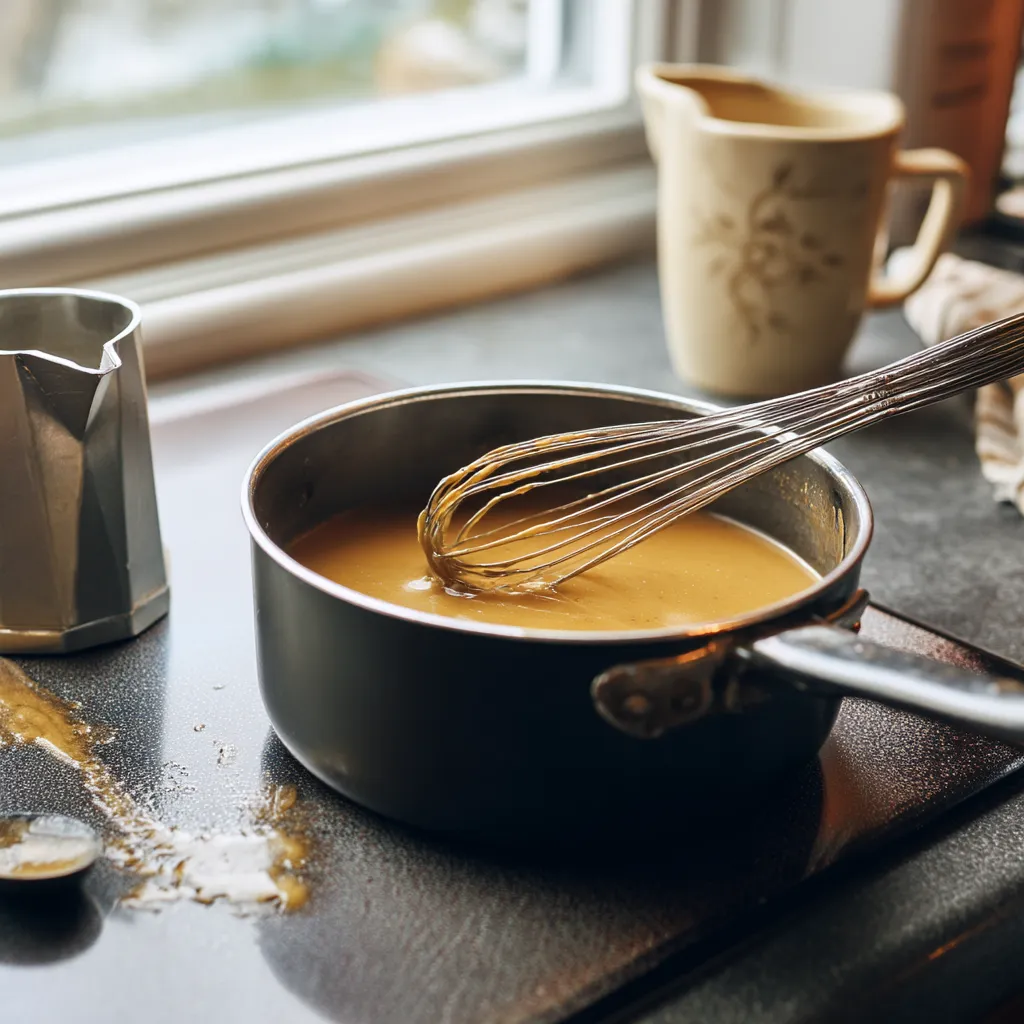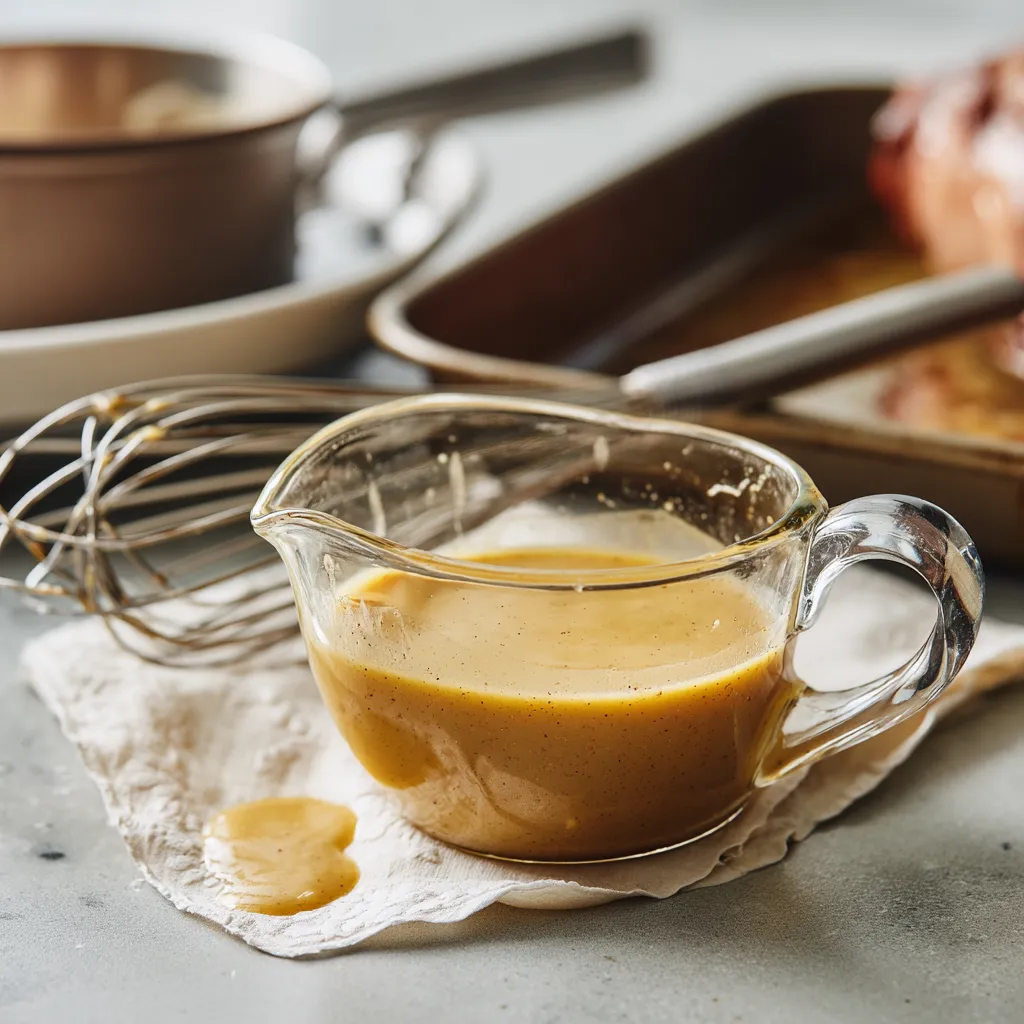 Save to Pinterest
Save to Pinterest This silky homemade pork gravy transforms ordinary meals into memorable dining experiences. The rich, savory flavor comes from real pork drippings, creating that authentic taste that store-bought versions simply cannot match.
I developed this recipe after years of watching my grandmother make Sunday roasts. What started as a way to use up pan drippings has become the most requested part of our family dinners, with everyone fighting over the last spoonful.
Ingredients
- Pork roast drippings create the foundation of flavor consider them liquid gold for your gravy
- Beef broth adds volume and depth when you need more liquid than your roast provides
- Unsalted butter provides richness and helps form the roux for perfect thickening
- All purpose flour creates the perfect texture when combined with butter gives you control over thickness
- Salt and pepper for seasoning always taste as you go to get the perfect balance
Step-by-Step Instructions
- Prepare Drippings
- Strain your pork drippings through a fine mesh strainer to remove any solid bits or excess fat. You want to capture all those flavorful juices while leaving behind anything that would make your gravy gritty. Measure out 2¼ cups and supplement with beef broth if you don't have enough drippings.
- Make the Roux
- Melt butter completely in a medium saucepan over medium heat until it foams slightly but doesn't brown. Sprinkle in the flour gradually while whisking continuously to prevent lumps. Continue whisking for a full 1 to 2 minutes this cooking step removes the raw flour taste and creates a proper foundation for your gravy.
- Build the Gravy
- Add the first portion of drippings very slowly about a tablespoon at a time while whisking vigorously. This gradual addition prevents lumps from forming. Once you have a smooth paste, you can add the remaining liquid in a thin stream, whisking constantly to maintain that silky texture.
- Simmer to Perfection
- Allow the gravy to come to a gentle bubbling simmer not a rolling boil. Reduce heat and continue simmering for 3 to 5 minutes, whisking occasionally. Watch for the transformation from thin liquid to coating consistency. The gravy will continue thickening after removal from heat.
- Season and Serve
- Taste your gravy and adjust the seasoning. Start with small amounts of salt and pepper as the drippings may already contain seasoning from your roast. Serve immediately while hot for the best flavor and texture.
 Save to Pinterest
Save to Pinterest The butter in this recipe is non negotiable in my kitchen. I once tried to make this gravy with margarine during a butter shortage, and the family immediately noticed the difference. The pure richness that real butter provides creates that velvety mouthfeel that makes people ask for your recipe.
Storage Solutions
This gravy maintains its quality beautifully when stored properly. Refrigerate in an airtight container for up to 3 days, where it will thicken considerably. When reheating, add a small splash of broth or water and warm gently over low heat, whisking to restore the smooth consistency. For longer storage, freeze in portion sized containers or ice cube trays for up to 3 months. These gravy cubes become instant flavor bombs for future meals.
Clever Variations
Transform this basic pork gravy into something special with thoughtful additions. For an elegant twist, add 2 tablespoons of good quality Dijon mustard and a splash of cream for a sophisticated pork Dijonnaise gravy. Herb lovers can infuse the gravy with fresh thyme and sage during simmering, then strain before serving. For a deeper flavor profile, consider adding a tablespoon of Worcestershire sauce or a splash of red wine to the pan drippings before making your gravy.
Troubleshooting Tips
Even experienced cooks occasionally face gravy challenges. If your gravy develops lumps, strain it through a fine mesh sieve or blend with an immersion blender. Too thin? Create a slurry with equal parts cold water and flour, then whisk in a teaspoon at a time until desired thickness is reached. Too thick? Simply add additional broth or water gradually while whisking. Remember that gravy continues thickening as it cools, so it's better to err on the slightly thinner side initially.
 Save to Pinterest
Save to Pinterest Common Recipe Questions
- → What can I substitute if I don't have enough pork drippings?
If you don't have the full 2¼ cups of pork drippings, beef broth makes an excellent substitute. Chicken broth can also work in a pinch, though it will produce a lighter flavor. For the richest taste, try to use at least 1 cup of actual pork drippings and supplement the rest with broth.
- → How can I make this gravy gluten-free?
To make gluten-free pork gravy, substitute the all-purpose flour with either cornstarch or a gluten-free flour blend. When using cornstarch, use half the amount (2 tablespoons instead of 4) and mix it with a small amount of cold water before adding to create a slurry. This prevents lumps and ensures smooth thickening.
- → Why is my gravy lumpy and how can I fix it?
Lumpy gravy typically results from adding liquid too quickly to the roux. To fix existing lumps, vigorously whisk the gravy, or for stubborn lumps, strain through a fine-mesh sieve. To prevent lumps, ensure your butter and flour paste is smooth before slowly adding small amounts of liquid while continuously whisking.
- → Can I make this gravy ahead of time?
Yes, this pork gravy can be made up to 3 days ahead and refrigerated in an airtight container. When reheating, warm gently on the stovetop over medium-low heat, adding a splash of broth or water if needed to adjust thickness. It can also be frozen for up to 3 months in freezer-safe containers.
- → What herbs or flavorings complement pork gravy?
Pork gravy pairs wonderfully with herbs like thyme, sage, and rosemary. For additional flavor dimensions, consider adding a splash of wine, apple cider, Worcestershire sauce, or Dijon mustard. A touch of cream added at the end creates a richer, silkier texture, while a few drops of liquid smoke can enhance the savory quality.
- → How can I make my gravy darker and more flavorful?
For a deeper color and flavor, cook your roux longer until it reaches a medium-brown shade before adding liquids. You can also add a teaspoon of soy sauce, a few drops of kitchen bouquet, or a small amount of instant coffee. Browning the butter slightly before adding flour will also contribute to a richer final product.